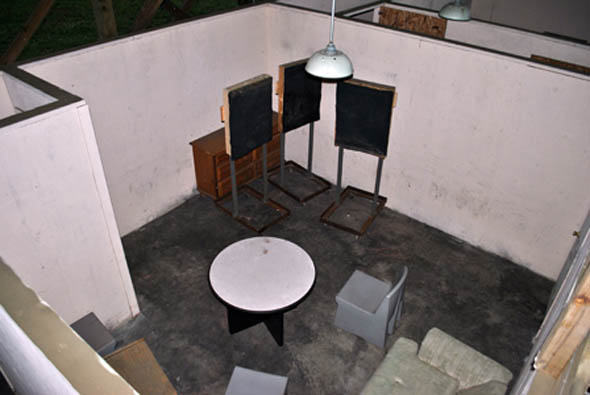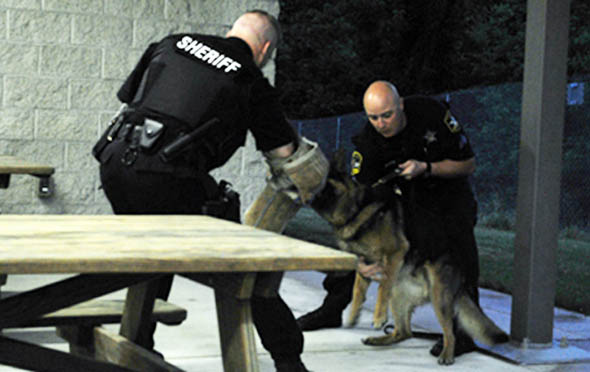The pursuing officers heard the command as they edged along the fence in a backyard in Windsor Valley, “Drop the gun!” As they learned they dropped to a crouched position expecting the confrontation. The K-9 unit, handled by Sgt. Donald Gividen, in the lead position gave the command again, “Drop the gun!” Captain Bowman crept forward to see what the K-9 unit had found. The dog had found the weapon and had picked it up to show his handler.
Now that the evidence was recovered they could get the criminal. Crouched down in the bushes in the backyard they simply waited for the suspect to come back for the weapon. Caught by the glow of his BIC lighter as he searched the fence line the home invasion from the call for service was brought to a close.
The K-9 unit is one part of the training facility utilized by the Sheriff’s office about 800 yards from the Order of the Arrow camp site at Broad Creek Memorial Scout Camp in northern Harford County. In fact, the facility is leased from the Boy Scouts of America even though it is primarily used only when school is in session.
Run by DFC Tony Boer, a former Baltimore County officer with experience in both K-9 and SRT, the indoor firing range serves as the primary firearms school for new recruits as well as yearly training for officers for handguns, shotguns, and rifles. Two ranges are on the property, one with stationary targets with longer shooting positions, and one with turning targets. “I can control the targets either manually from the tower or by writing an automated program,” said DFC Boer. “When we say two rounds in four seconds, we mean it. You either get it or you fail.”

One room of the live fire shoot house, set up for SRT training. (Photo by Mark Elloff)
For SRT qualification there is a live fire shoot house that is rated with pistol grade steel. While the targets are capable of stopping rifle rounds, they are never used due to officer safety. Other measures, such as using compressed copper bullets instead of lead, and careful oversight by at least two supervisors while the shoot house is in use is paramount.
Officer safety is always key – a point also stressed by Lt. Mike Crabbs, Dive team commander. “We are primarily a recovery unit,” stated Lt. Crabbs. “I’m not going to risk officers by sending them into an unsafe situation. We understand it is hard for family’s to hear, but the body will still be there when we can get to it.” Luckily, the vast majority of the Dive team’s work is for evidence collection. Their first goal is forensic underwater recovery – analyzing and photographing the underwater crime scene before removing anything.
The unit comprises of nine team members – six divers and three boat handlers with one member cross trained for both duties. They operate two vehicles – a twenty-one foot Boston Whaler and a sixteen foot inflatable Zodiak. Training occurs ten months out of the year, typically at Bainbridge Quarry in Pennsylvania. Being a dump location for stolen cars adds to the challenge of the training, but also can lead to interesting interdepartmental relationships. When the Dive team notices new cars in the quarry they contact the Pennsylvania State Police. Once, after a calling out the PSP several times to identifying cars, the PSP requested that the team “stop running tags while training.”
For the K-9 unit, there is one dog specifically used for recovery efforts, especially kids and the elderly. The unit’s bloodhound is the only of nine dogs that is solely used for searching. “The only danger when she finds you is that she will jump up and kiss you,” according to DFC Marty Hoppa. She is one of nine dogs that comprise the unit, including seven German Shepherds used for tracking and defense, and a lab used for drug detection.
All of the departments dogs come from either the Czech Republic or Slovakia and are trained on a variety of commands in a foreign language and English. “We don’t always want someone to know what command we are giving the dog,” said DFC Hoppa. His dog, Bruno, speaks Dutch. “Her original owner was from the Netherlands, but sold her through our breeders. We didn’t intend on teaching her Dutch.”
At a cost of $6,400 per dog, there are many tests that must be passed before training can begin. Dogs must have a drive to work, ability to use their nose, and most importantly courage. Each dog comes with a warranty and can be returned if they do not show the necessary traits. Returned dogs are usually repurposed now as search and rescue as opposed to police work. Training consists of a fourteen week basic school teaching obedience, how to track, and how to bite. “The dogs are taught to grab and hold on. The natural reaction is to pull away from the dog. So the dog pulls back,” said DFC Hoppa. “Now you are playing tug of war with the dog. And you are going to lose.”

DFC Hoppa, left, and Sgt. Donald Gividen, left demonstration the K-9’s capability. (Photo by Mark Elloff)
After passing basic training, they graduate to a six month narcotics detection school. No matter how cleverly a criminal tries to conceal drugs, the dog can still pick out the smell. “The dog can smell the particles of skin that fall off us constantly, broken grass from walking across a lawn, and even fear,” said DFC Hoppa.
The K-9 unit was integral in finding Donnell Graham during the investigation into the stabbing death at the Seasons apartments last year. When Graham was confronted by officers he smelled of alcohol and cigarettes, but his clothes were “Downey fresh.” “We took the dog around the bushes and found his discarded pants with the knife used in the crime in them,” according to DFC Hoppa.
While the business relationship with the dogs label them “a tool,” all of the officers admit that there is more of an emotional attachment. “I spend more time with the dog than I do my family,” said DFC Hoppa, “He is at home with me and my family, he goes to work with me, he sleeps at the foot of my bed. We are never apart.” A point that was brought home when the HCSO participated in a ship boarding training session with the Navy SEALS. “They talked about their dogs strictly as tools, because they can go back and trade out for a newly trained army dog anytime they need,” he said. “We invested a lot of money and time into our dogs. They aren’t just a tool.”
NEXT WEEK: Youth services division and a self protection lecture and demonstration.



I wish to thank you for that point you have made on paper this web site post. I’m wishing the identical appropiate product of your stuff later on too. Really your creative composing ability has influenced me personally to start my own, personal blog now. Actually the blogging is spreading it’s wings quickly. Your write up is really a good illustration of this.